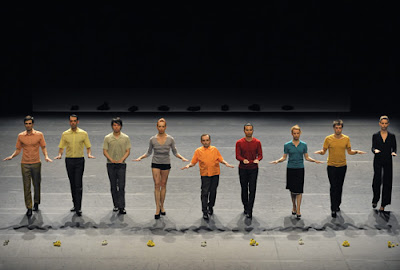At a work Christmas party tonight, I talked with a colleague about the density and complex chaos of the Wooster Group’s productions. And as I rode my bike home through the snow, I thought how the performance I saw on Saturday night, Raimund Hoghe’s Si je meurs, laissez le balcon ouvert, might possibly be as diametrically opposed to the Wooster Group as it is possible to be. Hoghe’s collage of dance styles and traditions, dissolving from Romanticism into abstraction, seemed to move at a pace as gentle as the Wooster Group’s performances are frenetic. Where the Wooster Group pack a kaleidoscope of people, things, times and spaces, as well as geographical locations, theatrical traditions and oeuvres onto the tiny stage of the Performing Garage, Hoghe’s stage is sparsely populated, lonely, intensely introspective, lyrical and abstract. Where I have come away from seeing the Wooster Group in the past marveling at their ability to create profundity out of a chaotic layer upon layer of texts, images, bodies, cacophonic dialogue, and sets that are constantly on wheels, in motion, I came away on Saturday night with a sense of quiet awe at the serenity of Si je meurs, laissez le balcon ouvert.
 |
| Takashi Ueno and Marion Ballester |
Si je meurs laissez le balcon ouvert is supposedly an homage to Dominique Bagouet, the young dancer who died of AIDS last year. But when Hoghe appeared in a soft silk dress, my friend Anne leaned across and reminded me it was a Pina Bausch dress. Hoghe quietly moved a hand, raised the shoe lace straps, placed his arm around the tall woman next to him, quietly and gently offering one of the few moments of human contact in the entire performance. As if in homage to Bausch, such gestures resonate throughout the performance to create something beautiful, strange, tragically hopeful. Si je meurs laissez le balcon ouvert was, like a Bausch performance, a surreal reflection on death, memory, hatred and desire, none of which can be pinned down.
And then Hoghe appears appeared in a black jester’s hat and a long black coat, I imagine paying homage to Dominique Béjart who also died recently in 2007. Like Béjart’s most celebrated productions, Hoghe’s work appears so simple that there are times when it seems as though not so much is happening on the stage. But it is in the raising of a hand, or the peeling of an orange (as Hoghe does opposite Ornella Balestra in a breathtakingly beautiful scene) that everything about being human, every desire and frustration, is revealed. And like Béjart, Hoghe places the young male dancer in the spotlight. Witness Emmanuel Eggermont shift from burlesque through pantomimic and classical dances to his closing solo in which he twists and turns his body such that it becomes an abstraction in the slowly fading spotlight. He was, in many ways, the highlight of Si je meurs laissez le balcon ouvert. Thus, this is a piece about death, loss, memory, about the end of the twentieth century, the end of an era in modern dance, an era which was shaped by three masters who recently died: Pina Bausch, Dominique Béjart and Merce Cunningham. And it is simultaneously a celebration of the life of the male body.
 |
| Emmanuel Eggermont |
Faced with the difficulty of interpreting Si je meurs laissez le balcon ouvert, I am left simply observing a work filled with confrontation, pain and remorse. The confrontation extends limitlessly: between texts taken from Goethe, Lorca, and others, music of all eras and genres, between the rich variety of colors and the death of black that cloaks their bodies, between death and the life that is invited in through the open doors of the balcony, between the dance styles of Bausch, Béjart, Cunningham, all of which, for Hoghe, begin with the classical. And then, as Balestra stands tall, imposing, completely possessed of her own grandeur stands as if on her balcony, and as she beckons her audience below to adore her, I am reminded that the confrontation extends into the space between life and representation. As Si je meurs laissez le balcon ouvert slides into the world of representation, we are invited to occupy that space opened by the death of representation and of dance in the twentieth century, as well as that space of mourning that we drift in and out of in the unconsciousness of loss. This is the only way to explain why it is so mesmerizing.


No comments:
Post a Comment